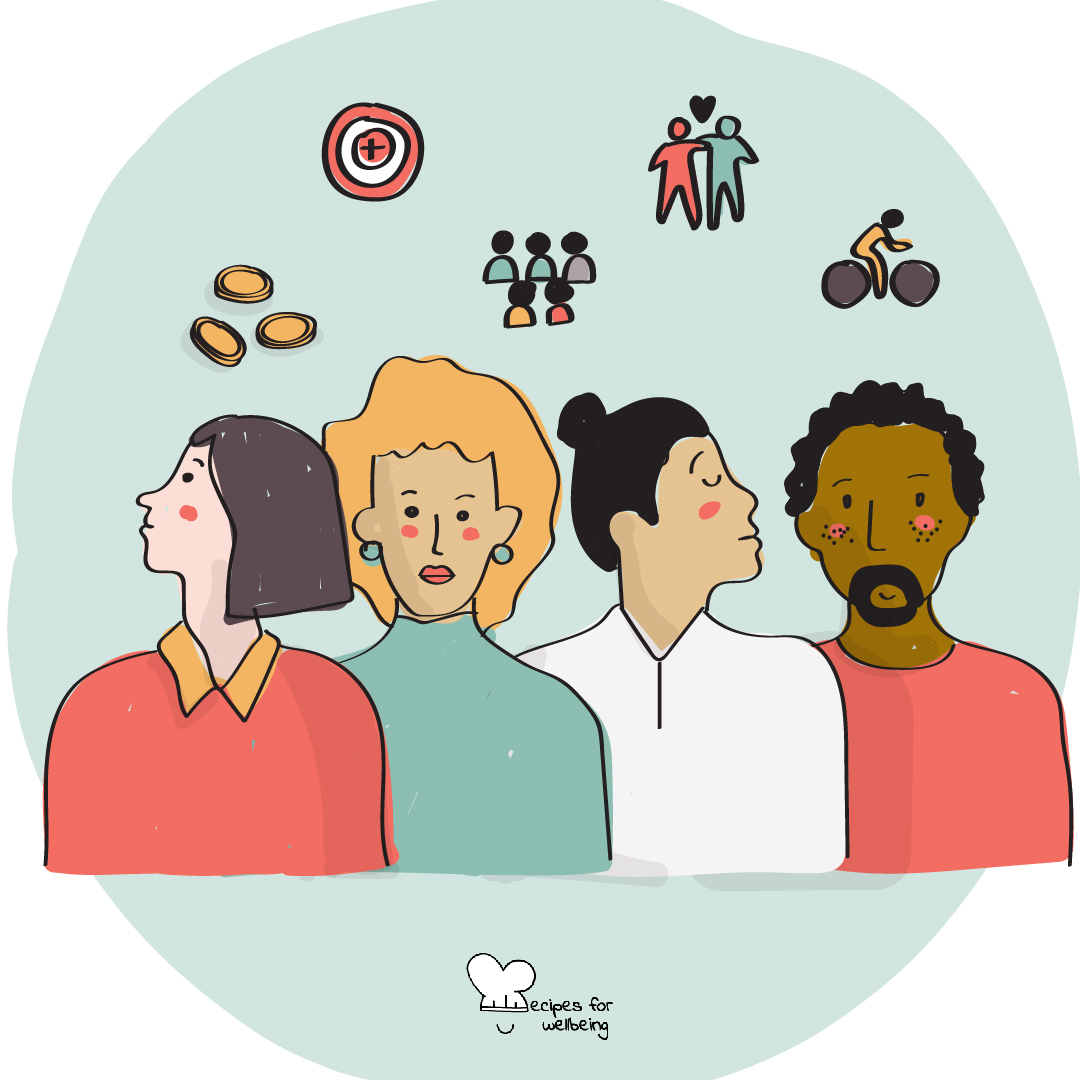
Gallup Well-Being Index
Combining strengths and wellbeing at work is potentially the most transformational treatment yet in the urgent pursuit of resiliency, mental health and ultimately, net thriving. ―Jim Harter
👥 Serves: 11-25 people, 2-10 people, 26-40 people, 41+ people
🎚 Difficulty: Hard
⏳ Total time: Half a day
🥣 Ingredients: All the members in your team/organisation, someone with experience administering wellbeing surveys
🤓 Wholebeing Domains: Community, Meaning, Positive Emotion
💪 Wholebeing Skills: Community-building, Contentment, Hope, Non-extracting, Optimism, Significance

Gallup Well-Being Index
📝 Description
Improve wellbeing by using the Gallup Global Well-being Index.
The Gallup National Health and Well-Being Index uses decades of clinical research, health leadership, and behavioural economics research to better understand the key factors that drive well being amongst people living in the United States. It began in 2008 and currently surveys 500 people daily as a unique approach to gathering data. More than 2.7 million surveys have been conducted since 2008.
The index looks into seven interrelated elements linked to wellbeing, including access to basic needs, one’s career and future, physical health, emotional health, healthy behaviours, financial situation, and a sense of community. The Well-Being Index brings together experienced and evaluative wellbeing, for a new understanding of the effect of wellbeing on respondents’ daily experiences and their overall lives. Evaluative wellbeing looks into the evaluation that people make about their life by reporting how satisfied they are, where experienced well being is about positive and negative emotions that people have on a daily basis.
The Gallup Well-Being Index is useful for organisational leaders who are interested in improving the wellbeing of their team or organisation. When your team or employees’ wellbeing is thriving, your organisation directly benefits – or the opposite can happen, too.
This recipe has been inspired by the work of Gallup, an American based global analytics and advice firm, and written by our wellbeing content writer collaborator Marissa Del Mistro.
👣 Steps
Step 1 – Identify a survey administrator (30’)
Looking into the individual skill set of everyone involved in the organisation, determine who is best suited to administer the survey (which will be discussed in step 2) to the organisation. We can call this person the wellbeing survey administrator. This should be someone with the following skill set and experiences:
- Writing reports and publications
- Gathering, processing, and evaluating data
- Experience conducting interviews
- Experience entering data/information into computer databases
- Awareness, empathy, and caring for others
- Collaboration skills
- Clear communication skills
- Strong conflict management and resolution skills
If this is not someone in the organisation, look to hire someone from outside the organisation on a contractual/temporary basis.
Step 2 – Choose the layout of the survey (45’)
Collaborate with the wellbeing survey administrator to identify the most suitable layout for your team or organisation. Is it easier for your team and the wellbeing survey administrator to complete the survey on paper or online? Do you want the survey to be anonymous or identifiable?
The Gallup Well-being Index asks respondents to evaluate their lives in the present moment, and their lives five years from now by imagining a “ladder” with steps numbered from 0 to 10, where “0” represents the worst possible life and “10” represents the best possible life. Based on their responses, there are 3 main “categories”.
- Thriving: Respondents who reply a 7 or higher are considered to be “thriving”. Thriving, in these terms, means the respondents have their basic needs met, have higher incomes, are less burdened by disease, report fewer sick days, and have better work environments.
- Struggling: Folks who score between 5 and 6 are considered to be “struggling”. Struggling, in these terms, means the respondents are neither thriving nor suffering and tend to live a moderate life and are more likely to stress and worry about meeting their-day-to day needs.
- Suffering: Finally, respondents between 0 and 4 are considered to be “suffering”. Suffering, in these terms, means that the respondents are less likely to have their basic needs met, including healthcare, are more likely to be burdened by disease, report having more sick days, and are at a higher risk of being divorced or widowed.
Step 3 – Use the Gallup survey (1.5 hours)
Once you have determined the best layout for your survey, you can look to the Gallup survey for the questions to ask, as the content of the survey was created using expert judgement and prior statistical analyses.
The survey is accessible via this link and costs $21 USD (€19.88) for four participants, or $5.25 USD (€4.97) per person. Therefore, the price will vary depending on how large – or small – your organisation is. The wellbeing survey administrator can work closely with individuals to complete the step of getting the survey done by everyone.
The Gallup Healthways Well-Being Index was designed to measure several broad conceptual domains (with particular emphasis on health). These are:
- Life Evaluation, which looks at measuring an overall view of life in the present and hope for the future. Questions include if someone is content with where they are in life, and if they are satisfied with their weeks.
- Access to Food/Shelter/Medicine, which asks about consistent and regular access to healthy, nutritious food, a safe shelter to rest every night, and access to medicine for any health problem.
- Emotional Health/Daily Affect, which assesses one’s overall mood, stress levels, anger, as well as susceptibility to ailments such as depression and/or anxiety. It also incorporates questions on the amount that one smiles, laughs, learns a new skill, feels respected, feels sadness, and experiences enjoyment.
- Disease Burden and Physical Health, which assess susceptibility to sick days in a month. It also asks about daily headaches, daily energy, daily colds, and flu. Finally, it questions how often one feels well-rested, about their weight, and any other health issues.
- Community Satisfaction and Access to Community Basics, which assesses one’s access to regular clean water, medicine, fresh produce/fruit, and a sense of safety. It also looks at aspects such as feeling safe while walking home at night, having access to an enjoyable community area, a doctor, and health insurance.
- Work Environment Quality, which assesses how work and employment is for people. Questions include things like satisfaction/dissatisfaction with one’s job, whether one uses their strength to do what they do best every day, whether one’s supervisor acts more like a boss or a partner, and whether they create an environment that is trusting and open.
- Healthy Behaviour, which assess lifestyle habits in relation to overall wellbeing and health. This section asks questions such as whether one smokes, has a healthy diet, exercises regularly, consumes fresh fruits and vegetables, etc.
Step 4 – Interpret the data (ongoing)
Once the information has been collated, it is time to understand the data and determine which steps need to be taken to improve the livelihood and wellbeing of your organisation.
As mentioned in step 1, the survey collates data numerically, and can be assessed by someone with experience in analytics to determine which respondents are thriving, struggling, and suffering.
Steps taken to make a change will vary depending on your organisation, but it is always good to take a holistic, all-encompassing approach. Some suggestions to look into are:
- Development: Do your development plans include wellbeing goals? Do you offer enough change for employees to build and grow new skills? You might be interested in our recipe “Identifying your goals and resources” to help team members move forward into their purpose.
- Recognition: Do you share and celebrate wellbeing successes? How? Is the recognition in line with how your team likes to be acknowledged? For example, some people do not like being called out in team meetings and would prefer a gift card to get a coffee or an afternoon off from work. For inspiration, check out our recipes “Gratitude fountain”, “Positive gossiping”, and “Sugar cubes”.
- Communication: Are your messages, especially from leaders and managers, consistent with a high-performing and net thriving culture? Are you asserting appropriate boundaries? Are breaks encouraged? How? You might find our recipes “Email like a boss” and “The ladder of inference” useful when thinking about your communication, and “Flow state” and “Pomodoro® Technique for Wellbeing” helpful to foster a high performing environment. Also, our recipe “Optimistic leadership” offers lots of insights into instilling a work culture that fosters positivity, accountability, and celebration.
- Incentives: Do available incentives inspire participation in activities that produce results? Are incentives realistic to the current economic climate in your country/community?
- Events: Do your events build awareness of net thriving culture and change behaviours? Are events relevant and enjoyed?
- Facilities: Is it easy to move around your office space, see outdoors and collaborate? Are there safe places to enjoy with pressure? Are there quiet areas? Check out our recipe “Creating the right work spaces” to encourage high performance in your organisation and “10 ways to enjoy happiness at work” for additional tips.

